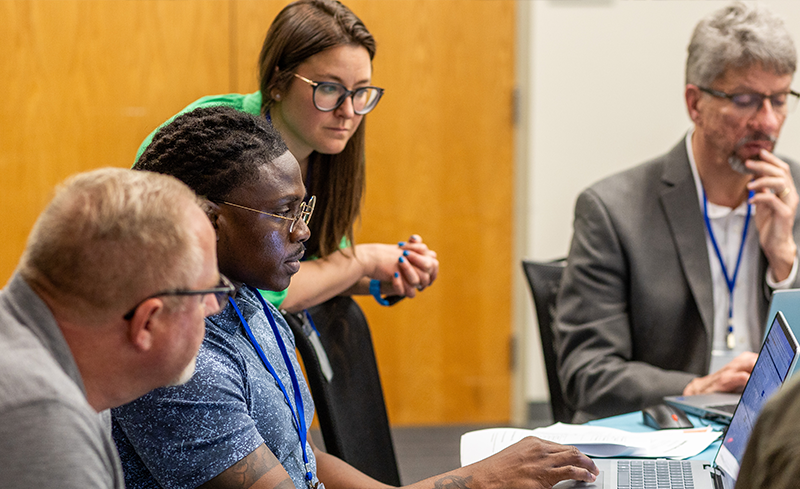Imagine a world where your YMCA or JCC's program and membership management software not only work in sync, but also adapt and scale in alignment with your evolving business needs. This is the power of an integrated CRM solution - consolidated data onto a unified platform, that streamlines operations across multiple business streams.
The end result? The elimination of manual work-arounds and costly, inefficient data silos; enabling you with a more efficient, scalable, and impactful organization.
Why does YMCA software data matter?
If you aren’t yet data-obsessed, you should be. When captured and managed efficiently, data can mean the difference between the success or stagnation of your nonprofit organization. The IBM Executive Report on Analytics shows that 78% of nonprofits with advanced analytics perform more efficiently. And while the importance of data is recognized across all industries, 74% of nonprofits in Salesforce’s Nonprofit Trends Report stated that measuring and reporting on data remains a challenge.
Community centers are vibrant hubs of activity - they're fitness centers, child care providers, rental facilities, program facilitators, and donation hubs. This equates to a vast amount of data reflecting the unique interactions individuals have with your organization. But, the power of all this data, only goes so far as its capacity to be centralized and actionable.
<hr></hr>When partnering with a YMCA, one of the first things we ask for is a list of tools used to run their business. Why? We often discover they're utilizing multiple systems. The biggest challenge is that these systems don't communicate with each other - they’re operating in silos. <hr></hr>
Getting your hands on real-time and accurate data can really change the game for your nonprofit in loads of ways:
- Leverage analytics to make smarter decisions: Diving into data trends and patterns can guide you in choosing what programs to offer, where to allocate resources, and when to engage in fundraising efforts. With a strategy to capture and monitor lead conversion data, the YMCA of Memphis and the Mid-South increased its member conversion rates by 40%.
- Get to know your unique community: Gain insights into demographic details, participation rates, and see how engaged they really are. This helps your organization really understand what your community needs and wants, so you can connect and serve with them in ways that resonate.
- Increase efficiency and get more done: By streamlining data management, processes and workflows run quicker and smoother. Eliminating duplicate entry and manual processes means saving time and effort, allowing staff to focus on what really matters, like the YMCA of Delaware having saved $500k annually in operational costs by processing staff administrative tasks centrally.
- Spot emerging trends and growth opportunities: Tracking key metrics and monitoring changes over time, you can adapt strategies to capitalize on emerging opportunities for growth or pivot away from initiatives that just aren't working. The JCC Chicago increased its financial assistance support to 400 families after building an application process that documented the history and recognized those on the cusp of financial need.
The challenges of disconnected systems in nonprofit management software
Many YMCAs utilize a CRM platform to manage their day-to-day business operations. However, not all CRMs are created equal, and the effectiveness of these YMCA software varies when it comes to capturing data, automating workflows and supporting your initiatives.
When we start working with a YMCA, one of the first things we ask for is a list of all the tools used to run their business. Why? We often find that they are utilizing multiple systems to manage their wide-range of services and business. One of the biggest challenges we discover is that these systems don't integrate or communicate with each other - they’re operating in silos.
This array of disconnected tools often leads to a fragmented workflow, challenging to understand and even more frustrating to work with. As a result, manual workarounds become the norm, devouring valuable time and resources that could be better invested elsewhere.
Impacts on your staff:
- Time-intensive manual processes: Staff spend too much time cross-referencing data from multiple sources, leading to inefficiencies and decreased productivity.
- Risk of duplicate and inaccurate data: Manual data entry can potentially lead to errors or increase the risk of inaccuracy being entered into your system.
- Trouble working together: Siloed systems stand in the way of cross-department and branch collaboration, blocking staff's ability to unite in their business planning and community projects.
- Struggle to get a complete picture: The challenge of merging data from different sources means we often miss out on understanding the unique ways individuals interact with our organization. This gap hinders the ability to tailor or expand engagement and communications.
Impacts on your community members:
- Limited personalization: Disparate systems complicates the ability to personalize interactions based on preferences or history. This can lead to missed opportunities to engage them in relevant programs or fundraising efforts leading to an impersonal experience.
- Difficulty in tracking engagement: The lack of a unified view makes it challenging to track and analyze various touchpoints which can get in the way of efforts to understand behavior and trends.
- Negative user experience: Multiple systems, multiple logins, or entering the same data repeatedly for program sign ups and registrations, leads to a disjointed experience and time-intensive process for your members.
For YMCAs, JCCs, and nonprofit community centers, moving away from a disjointed system to a unified tech ecosystem that handles your data smoothly and reliably can make a big difference. Not only does it make it easier for your staff and streamline your operations, but it also greatly improves the experience for your community members.
A guide to building a holistic tech ecosystem for your YMCA
When building a holistic tech ecosystem, it's important to keep in mind key ideas like consolidation, centralization, and making sure your systems are flexible. Your YMCA software setup should be more than a patchwork of digital tools thrown together; it needs to be a well-thought-out tech framework that brings every part of your nonprofit management together in one place.
Begin with a solid foundation – a platform such as Salesforce with user-friendly tools for streamlined data management, encompassing reporting, workflow automation, and customer engagement tracking. Then, add on Traction Rec, a tailor-made solution designed specifically for nonprofit community centers, with features like member self-service, program management, child care services, facility booking, and comprehensive billing functionalities. All your data is right where you need it, making it easier to get a full picture of each community member.
<hr></hr>The real aim isn't just about adding more tools to your CRM; it's taking a thoughtful approach to making your operations management run smoother and more effective.<hr></hr>
Getting your tools to talk. What are integrations and why do they matter?
A critical, yet often overlooked, feature of the Salesforce platform is its integration capabilities. Integrations enable seamless connections between your CRM and an extensive suite of third-party tools you may want to utilize. Whether it's email marketing, fundraising tools, or visitor management applications - the exchange of data flows smoothly between software applications, eliminating data silos. This means you can do a whole lot more with your CRM than just what comes out of the box, making it way more capable, while still keeping your data neat and organized in one place.
What is Open-API?
Open-API (Application Programming Interface) refers to technology that is designed to allow third-party developers to integrate their software with other platforms. Think of it like a bridge that lets data flow smoothly back and forth between different tools. Working with an Open-API platform like Salesforce or Traction Rec means it can be flexible and scalable, all without creating a mess with your data.
Advantages of integrations for nonprofits
- Single source of truth: Consolidated data from various systems into a centralized hub means no more data silos.
- Less typing, more connecting: No more manual data input or duplicated efforts into multiple systems.
- Better insights: With all your data in one place, you can really get the full picture and make smarter decisions based on what the numbers are telling you.
- Flexibility and customization: Mix and match specialized tools that fit exactly what you need, all while keeping your main systems running smoothly.
- Future-proofing: Add new tools as your needs evolve, and limit worries about outgrowing your technology.
- Saving money: Integrating standard software tools can save more money compared to developing entirely new, custom features. These customizations often require time-intensive processes and ongoing maintenance costs.
Tailoring technology to fit your YMCA’s needs
When we talk about a digital transformation strategy with our partners, we focus on getting the full picture of what challenges you're facing with your technology today, what you need operationally now, and how those needs might evolve and grow into the future. The ultimate goal is not simply to integrate more tools with your CRM, but a thoughtful approach to making your operations management smoother and more effective.
Here's how we help you navigate which integrations are a good fit:
- We map the tech you're currently using, helping to spot where additional functionality could have a significant impact.
- Create a wish list based on your tech audit. We can leverage our knowledge and experience from other nonprofits utilizing them successfully.
- Tap into the knowledge of peers, and end users for valuable feedback to ensure recommendations resonate and will be adopted.
- Get the value you seek by ensuring alignment between your business priorities and outcomes.
- Consider budget implications to effectively balance costs and benefits.
Choosing the integrations right for you allows you to expand capabilities while maintaining the value of your core YMCA software CRM. Plus, you can integrate new tools any time, when your organization is ready for them. The ones you choose should not only support but enhance, every task, outreach and engagement.
You're on the path to building a stronger (and future-proof) YMCA with a centralized CRM
For YMCAs and nonprofit community centers, a centralized CRM system is more than a technological update—it's a smart step towards making sure you're set for the future and really making an impact with your mission. By capturing data together in one CRM and using integrations made just for what you need, your YMCA can work together smoothly for both staff and community members, leaving behind the pitfalls of fragmented systems.
Discover our integrations, and learn more about how we can support community centers like yours to magnify your impact.

























